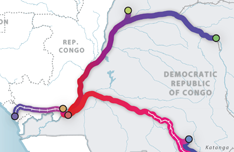We just published a paper in Science that uses phylogeographic approaches to uncover the early history of HIV-1 emergence and spread in what is now the Democratic Republic of the Congo (DRC). I played only a small role with this, Nuno Faria and Philippe Lemey are responsible for most of the research. Using modern phylogeographic methods and an extensive dataset isolates from the DRC, we establish that the HIV-1 group M viruses share a common ancestor in a virus that existed in Kinshasa, the capital of the DRC, sometime between 1909 and 1930. HIV-1 group M viruses represent one of multiple zoonotic transmission events that brought viruses endemic to the chimpanzee population into the human population. However, other transmission events resulting in HIV-1 groups N, O and P did not catch and spread the same way that HIV-1 group M viruses managed to; group M viruses now comprise over 90% of HIV infections worldwide. We find that HIV-1 group M viruses spread from Kinshasa to other parts of the DRC along rail and waterway connections starting in the 1940s. We also find evidence for an increase in transmission rate of viruses within Kinshasa from approximately 1960 to 1980, which is hypothesized to have resulted from the use of unsterilized injections at STD clinics. This work represents the most detailed investigation of the early origins of the HIV pandemic to date.
